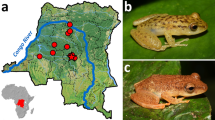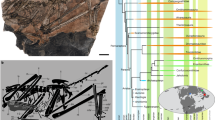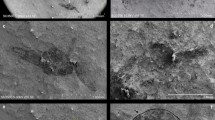Abstract
THE African frog Xenopus (a member of the family Pipidae), formerly found in Miocene1,2 and Recent deposits in Africa, is described here from the Palaeocene (∼ 60 Myr) of Brazil. Extant pipids are aquatic freshwater frogs, occurring in sub-saharan Africa (Xenopus, Hymenochirus, Pseudhymenochirus) and northern South America (Pipa, Protopipa, Hemipa). They display a mosaic of primitive and specialised characteristics and are generally placed as an ancient offshoot of early anuran stock. Both fossil and recent occurrences of the Pipidae are consistent with an ancient distribution exclusively across the southern continent3,5.
This is a preview of subscription content, access via your institution
Access options
Subscribe to this journal
Receive 51 print issues and online access
$199.00 per year
only $3.90 per issue
Buy this article
- Purchase on SpringerLink
- Instant access to full article PDF
Prices may be subject to local taxes which are calculated during checkout
Similar content being viewed by others
References
Ahl, E., in Die Diamantenwuste Südwest-Afrikas (edit. by Kaiser, E.), 141 (D. Reimer, Berlin, 1926).
Vergnaud-Grazzini, C., Notes Serv. geol. Maroc, 27, 43 (1966).
Estes, R., and Reig, O., in Evolutionary Biology of the Anurans (edit. by Vial, J.) (University of Missouri Press, Columbia, 1973).
Paula Couto, C. de, Notas prelim. Estad. Div. Geol. Minor. Bras., 75, 1 (1953).
Tinsley, R., J. Zool., 169, 1 (1973).
Douglas, R., Moullade, M., and Nairn, A., (edit. by Tarling, D., and Runcorn, S.), in Implications of Continental Drift for the Earth Sciences, vol. 1, (Academic New York, 1973).
Creer, K., ibid.
Estes, R., and Wake, M., Nature, 239, 228 (1972).
Reig, O., Ameghiniana, Rev. Assoc. paleontol. Argentina, 2, 73 (1961).
Paterson, N., Proc. zool. Soc. Lond ., 115, 327 (1945).
Mumsy, L., Copeia, 3, 584 (1972).
Brain, F. de., et al., C. r. hebd. Séanc. Acad. Sci. Paris, 279, 469 (1974).
Author information
Authors and Affiliations
Rights and permissions
About this article
Cite this article
ESTES, R. Xenopus from the Palaeocene of Brazil and its zoogeographic importance. Nature 254, 48–50 (1975). https://doi.org/10.1038/254048a0
Received:
Revised:
Issue Date:
DOI: https://doi.org/10.1038/254048a0



